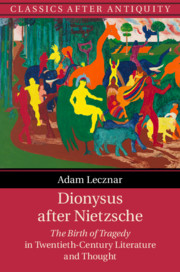Book contents
- Dionysus after Nietzsche
- Classics after Antiquity
- Dionysus after Nietzsche
- Copyright page
- Epigraph
- Contents
- Series Editors’ Preface
- Acknowledgements and Dedication
- Introduction
- Chapter 1 Corybants, Satyrs and Bulls
- Chapter 2 A Great Kick at Misery
- Chapter 3 In Search of an Absent God
- Chapter 4 What Oedipus Knew
- Chapter 5 Dionysus in Yorubaland
- Conclusion
- Bibliography
- Index
Introduction
Dionysus after Nietzsche
Published online by Cambridge University Press: 27 March 2020
- Dionysus after Nietzsche
- Classics after Antiquity
- Dionysus after Nietzsche
- Copyright page
- Epigraph
- Contents
- Series Editors’ Preface
- Acknowledgements and Dedication
- Introduction
- Chapter 1 Corybants, Satyrs and Bulls
- Chapter 2 A Great Kick at Misery
- Chapter 3 In Search of an Absent God
- Chapter 4 What Oedipus Knew
- Chapter 5 Dionysus in Yorubaland
- Conclusion
- Bibliography
- Index
Summary
The introduction explores the genesis of Dionysus and the Greeks in Nietzsche’s thought, from their initial appearance at the publication of The Birth of Tragedy in 1872 until his breakdown in Turin at the dawn of 1889. It argues that one of the central elements of their appeal to later authors is that Nietzsche used the Greeks to develop an innovative way of speaking about modernity. It was this explosive mixture of the archaic and the present that encouraged authors to consider the way that the example of classical antiquity could help them think through the rapidly changing conditions of their contemporary era. By examining different approaches to the temporality of antiquity and to ancient works of art, the chapter argues that Kracauer and Bloch’s idea of the ‘contemporaneity of the uncontemporaneous’ captures the way that classical antiquity exists in the present, as one obtrusion among many within a confusing fabric of competing times and experiences. This is also linked to the aesthetic and literary movement of modernism and to the vogue for tragedy that sprang up in the twentieth century.
- Type
- Chapter
- Information
- Dionysus after Nietzsche<I>The Birth of Tragedy</I> in Twentieth-Century Literature and Thought, pp. 1 - 33Publisher: Cambridge University PressPrint publication year: 2020



